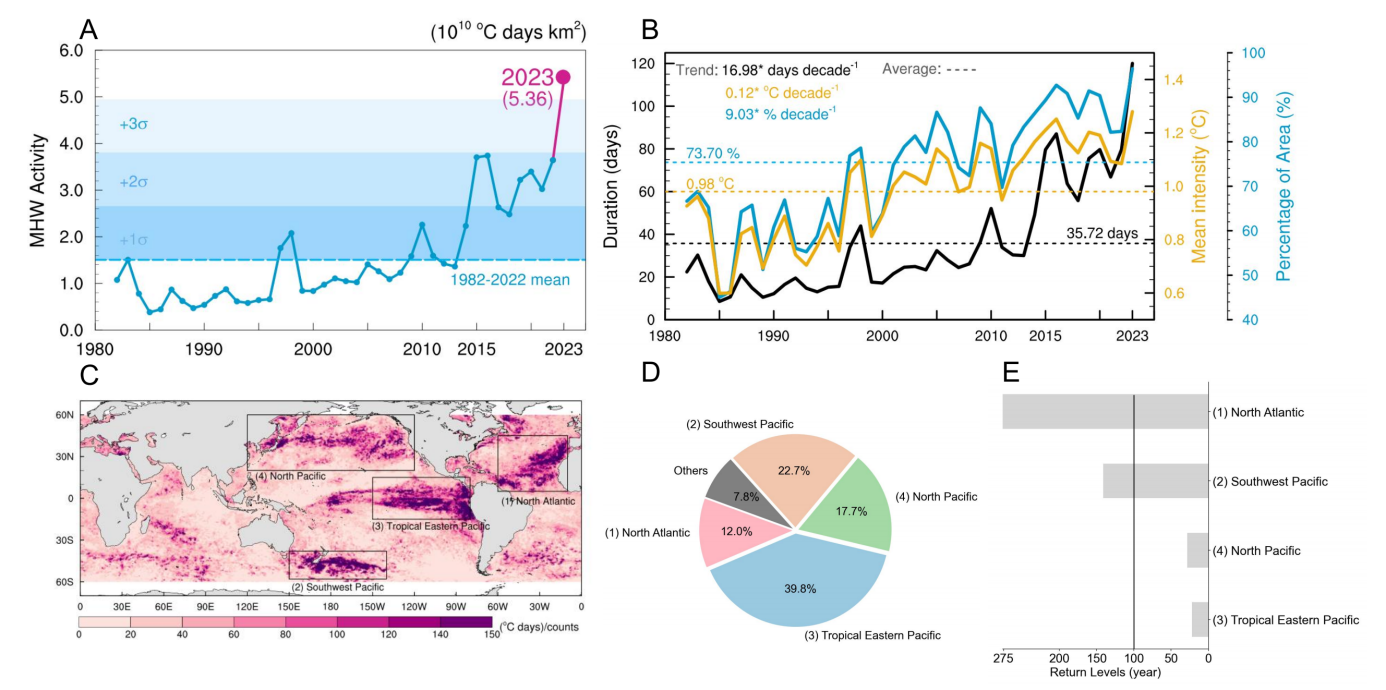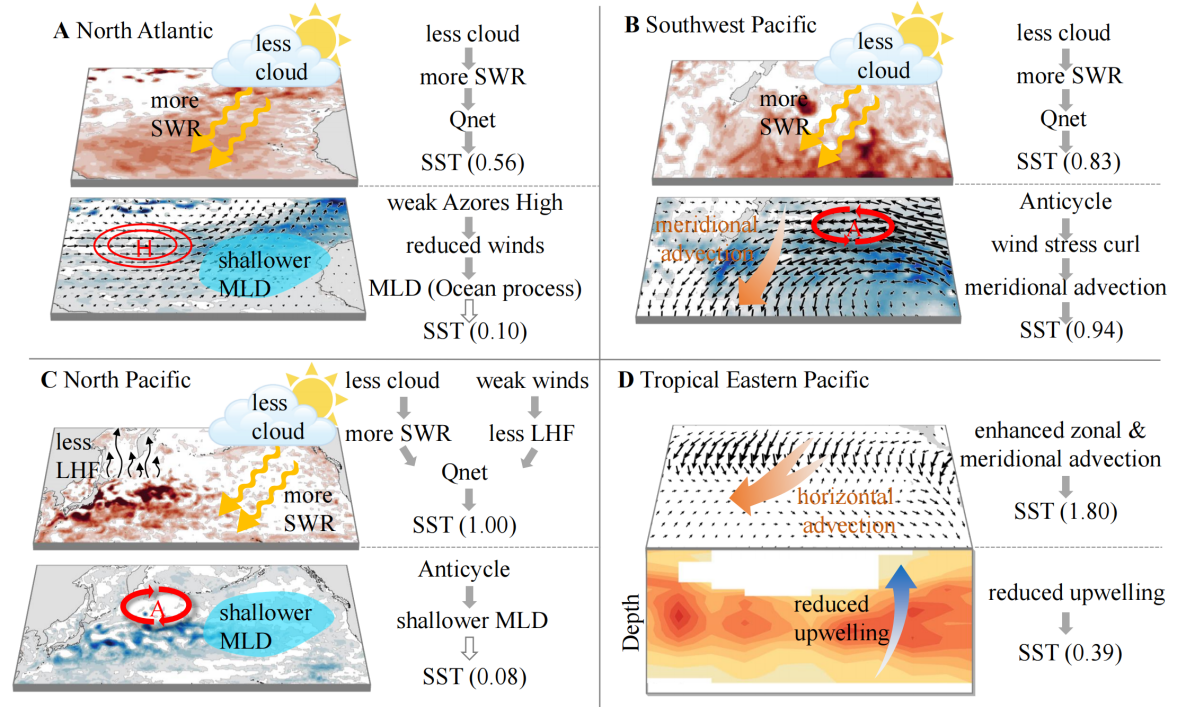Advancing Earth system science is essential for uncovering the underlying mechanisms of such complex climate phenomena, improving global climate forecasting capabilities, and formulating evidence-based adaptation strategies. By integrating data from the atmosphere, ocean, land, and biosphere, Earth system science offers a robust foundation for addressing global warming and escalating climate extremes.

A research team led by Professor Zhenzhong Zeng from the School of Environmental Science and Engineering at the Southern University of Science and Technology (SUSTech), in collaboration with partners, has provided a comprehensive analysis of the spatial distribution, temporal evolution, and key physical drivers behind the unprecedented marine heatwaves that swept across the global oceans in 2023.
Their groundbreaking study, titled “Record-breaking 2023 marine heatwaves,” has been published in the top journal Science.
The researchers developed a mixed-layer heat budget diagnostic framework based on high-resolution ocean reanalysis data, integrated with satellite observations. This framework enabled a quantitative characterization of the unprecedented intensity, duration, and spatial extent of global marine heatwaves in 2023, while also clarifying the dominant driving processes in several key ocean basins.
Their analysis revealed that simultaneous marine heatwave outbreaks occurred across multiple regions in 2023, signaling that the climate system is undergoing significant and complex changes. Their work further highlights substantial regional differences in the physical mechanisms driving these changes, providing critical scientific insights for understanding and predicting future extreme ocean events.
In 2023, the World Meteorological Organization (WMO) officially declared the year as the warmest on record, with both global sea surface temperature (SST) and ocean heat content (OHC) reaching unprecedented highs. According to the European Centre for Medium-Range Weather Forecasts (ECMWF) and the UK Met Office, SST anomalies in the North Atlantic soared to 1.3 ℃ above the climatological average in June 2023. NASA climate director Gavin Schmidt remarked, “We need answers for why 2023 turned out to be the warmest year in possibly the past 100,000 years. And we need them quickly.”

Figure 1. Total marine heatwave (MHW) activity in 2023 reached record-breaking levels, with several key ocean regions experiencing events far exceeding 100-year return period
Against the backdrop of exceptional ocean warming, extreme marine heatwaves have become a central focus of climate research, drawing widespread international attention for their underlying mechanisms and potential impacts. The research team found that total global MHW activity in 2023 reached 53.6 billion ℃ days km2—over three standard deviations above the historical norm since 1982. Notably, the North Atlantic and Southwest Pacific experienced exceptionally rare events, with estimated return periods of 276 years and 141 years, respectively.
In 2023, the global average duration of marine heatwaves reached 120 days, with some lasting up to 525 days. The average intensity was 1.3℃, and the spatial coverage of MHWs exceeded 96% of the global ocean surface, substantially higher than the 40-year historical average.
To uncover the physical mechanisms behind the formation of the 2023 marine heatwaves, the researchers conducted a mixed-layer heat budget analysis using ECCO2 high-resolution daily data. This approach enabled them to quantitatively assess the relative contributions of key thermodynamic and dynamic processes—including shortwave radiation, mixed-layer depth changes, oceanic advection, and upwelling—across different ocean basins.
In the North Atlantic, an anomalously weakened subtropical high led to reduced cloud cover and a shallower mixed layer. These changes, together with enhanced shortwave radiation and zonal advection, provided sustained energy to fuel the marine heatwaves. In the Southwest Pacific, intensified atmospheric anticyclones strengthened easterly winds and weakened the westerlies, enhancing meridional oceanic transport. Simultaneously, reduced cloud cover allowed more solar radiation to penetrate the ocean surface, further accelerating sea surface warming.
In the North Pacific, increased shortwave radiation combined with reduced latent heat loss, along with a shallower mixed layer, resulted in rapid surface ocean warming. In the tropical eastern Pacific, El Niño–driven changes in meridional and zonal advection, along with suppressed upwelling, collectively amplified regional ocean warming.

Figure 2. Schematic representation of the mechanisms driving the 2023 MHWs
The team suggests that global warming is intensifying the nonlinear coupling between the ocean and atmosphere, with marine heatwaves potentially serving as critical “early warning signals” of major shifts in the Earth’s climate system. The 2023 MHWs set new records in terms of spatial extent, intensity, and duration, posing serious risks to the frequency and strength of extreme weather events, oceanic carbon uptake, fisheries distribution, and coral reef ecosystems.
Advancing Earth system science is essential for unraveling the complex interactions among these nonlinear processes. It provides a solid scientific foundation for global climate governance, marine ecosystem conservation, and sustainable fisheries management in the face of escalating climate challenges. Looking ahead, building physics-based forecasting systems, enhancing real-time multi-parameter ocean monitoring, and improving early warning capabilities for extreme climate events will be critical to improving climate resilience worldwide.
Joint postdoctoral researcher Tianyun Dong from SUSTech and the Eastern Institute of Technology, Ningbo (EIT) is the first author of the paper. Professor Zhenzhong Zeng is the corresponding author, and SUSTech is the corresponding institution.
The co-authors include Professor Dongxiao Zhang from EIT; Professor Deliang Chen from Tsinghua University; Professor Ming Pan from the University of California, San Diego; Assistant Professor Yuntian Chen from EIT; Professor Laurent Z.X. Li from Sorbonne University; Researcher Tianjun Zhou from the Institute of Atmospheric Physics, Chinese Academy of Sciences; Researcher Dongzhi Zhao from the Nanjing University of Information Science and Technology; Professor Alan D. Ziegler from Kasetsart University; Associate Researcher Shuxin Luo from the Digital Twin (EIT) Research Institute; Dr. Shuai Yang from Lawrence Berkeley National Laboratory; and Dr. Dashan Wang, Lili Liang, Yubin Jin, Shijing Liang, and Xiaowen Huang from SUSTech.
Paper link: https://www.science.org/doi/10.1126/science.adr0910
To read all stories about SUSTech science, subscribe to the monthly SUSTech Newsletter.
Proofread ByAdrian Cremin, Yuwen ZENG
Photo ByYan QIU